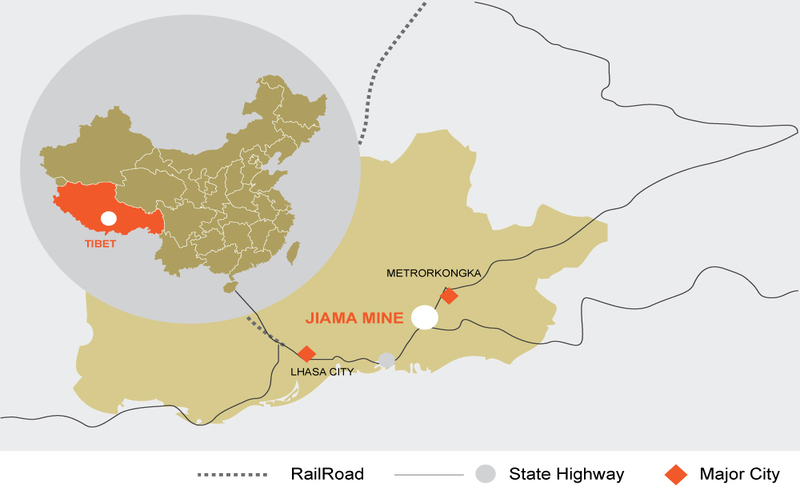
Jiama Copper Gold Polymetallic Mine in Tibet
Tibet, often referred to as the “Roof of the World,” is a region of immense natural beauty and profound spiritual significance. However, beneath its picturesque landscapes lies a wealth of mineral resources that have attracted extensive mining operations. One of the most notable examples is the Jiama copper-gold polymetallic mine, operated by China Gold International Resources. While such mines are hailed as economic boons for China, they pose severe environmental, cultural, and social threats to Tibet and its people.
After being closed for over a year due to a tailings overflow, China Gold International Resources has resumed operations at the Phase II processing plant at its Jiama mine near Lhasa, Tibet. A tailings dam, designed to store toxic byproducts of mining, failed on March 27, 2023, leading to the suspension of activities. The company has since repaired and reinforced the Guolanggou dam, receiving approvals from both the so called Tibetan and Chinese governments. The Phase II plant now operates at a daily capacity of 34,000 tonnes, while the smaller Phase I plant, which resumed in December 2023, will cease operations. Additionally, construction of a new Phase III tailings dam is underway, expected to be operational by mid-2026. For 2024, the company targets production of 95-98 million lb. of copper and 42,439-45,333 oz. of gold from the Jiama mine, alongside substantial output from its CSH mine in Inner Mongolia.
Environmental Degradation
The Jiama mine, along with other large-scale mining operations in Tibet, has significantly contributed to environmental degradation. The most immediate impact is on the region’s water resources. Mining processes often lead to contamination of local water supplies with heavy metals such as copper, lead, and arsenic. This pollution not only affects the health of the local population but also disrupts the delicate ecosystems of Tibet’s rivers and lakes.
The incident of the tailings overflow at the Guolanggou dam in 2023 is a stark reminder of these risks. Despite repairs and reinforcements, the potential for future spills remains a concern. Such overflows can result in toxic substances being released into the environment, posing long-term hazards to both human and animal life.
Cultural and Spiritual Erosion
For the Tibetan people, the mountains and valleys are more than just landscapes; they are sacred spaces intertwined with their spiritual beliefs and cultural heritage. The Jiama Valley, for example, is not only a mining site but also the birthplace of Songtsen Gampo, the first king of the Tibetan Empire. The establishment of mines in these areas is seen as a desecration of holy lands, preventing pilgrims from accessing sites of historical and religious importance, such as ancient caves and rock paintings.
The large-scale alteration of the landscape due to open-pit mining and the construction of processing plants has marred the natural beauty of these sacred sites, creating a lasting impact on the cultural identity of the Tibetan people.
Social and Ethnic Tensions
The influx of workers from other parts of China, primarily ethnic Han, has exacerbated ethnic tensions in Tibet. The 2013 avalanche at the Gyama mine, which buried 83 miners, highlighted this divide. Of those buried, only two were Tibetan, while the rest were Han Chinese. This demographic shift fuels resentment among Tibetans, who see their lands being exploited by outsiders while they reap little benefit.
Moreover, the presence of non-Tibetan workers and managers often leads to a sense of disenfranchisement among the local population. The perceived inequity in job distribution and the environmental degradation caused by the mines contribute to ongoing social unrest and dissatisfaction with the Chinese government’s policies in the region.
Economic Disparities
While the mining operations are touted as economic drivers, bringing infrastructure and development to remote areas, the benefits are often unevenly distributed. The profits primarily flow to the mining companies and the central government, with limited reinvestment in the local Tibetan communities. This economic imbalance further marginalizes Tibetans, who bear the brunt of environmental and social costs without enjoying proportional economic gains.
Conclusion
The Jiama mine and similar operations in Tibet illustrate the complex and often destructive impact of large-scale mining on environmentally sensitive and culturally rich regions. While these mines may bolster China’s economic growth, they do so at a significant cost to Tibet’s environment, culture, and social fabric. Sustainable and equitable development in Tibet requires a more balanced approach that respects the region’s unique heritage and addresses the needs and rights of its indigenous people. Without such measures, the mining boom threatens to become a long-term catastrophe for one of the world’s most unique and fragile regions.